Use of piroxicam in Chronic Pelvic Pain. A double blinded controlled study.
Use of piroxicam in Chronic Pelvic Pain. A double blinded controlled study.
Approbato, MS; Florencio, RS; Amaral,WN; Batista, SRR;Fonseca, TD; Perini,GF.
Human Reproduction Laboratory. Dept of Gynecology andObstetrics, Medical College, Federal University of Goias State,Brazil.
Introduction
Chronic pelvic pain (CPP) affects a large number of women, beingone of the most frequent challenges to gynecologists. It notalways responds to conventional treatment. It is considered that10-15 % of new referred patients are coming due to CPP.
Though most of CPP are caused by psychological factors,pharmacological treatment is used like non-steroidsanti-inflammatory drugs, opioids, hormonal modulators ortricycle antidepressants, serotonin selective recaptationinhibitors and anticonvulsivants. Some authors opted forsurgical treatment.
Patients and Methods
Piroxican belongs to non-steroidanti-inflammatory class of drug, has antipyretic and analgesicproperties. Edema, erythema, pain and tissular proliferation canbe inhibited according to researches in animals. In our study 60patients with CPP (two or ore of the following factors: pelvicpain for six or more months, pareunalgy, pain on uterinemobilization and pain on palpation of the low abdomen. Hemogramand urine specimen were requested to exclude infection. Patientsusing analgesic or antibiotics were excluded of the study.Patients were randomically divided in three groups of 20. Eachgroup received in a randomically and double blind way, one ofthe following medicines (suppository): piroxican 20 mg (P20),piroxican 30 mg (P30) or placebo, once a day for 10 days. Ananalogical 1 to 10 scale was used to score the pain. Patientswere told to mark the pain score in first day before usingmedication and after 2, 4, 5 hours after administration. Theywere also informed to return to office from 2 to 7 days afterthe end of treatment, so new scores were marked. Bloodsedimentation (Westergreen) was studied before and aftertreatment. Statistical analysis was proceeded by ANOVA forrepeated measures.
Results
Pain lasts from 6 months to 30 years. Figure1 shows the effect of time and treatments. Both time (P = 0,053)and treatment (p=n.s.) did not reduce significantly the pain inthe first day, after 2, 4, and 6 hours of drug administration(There was no difference between drugs and placebo).
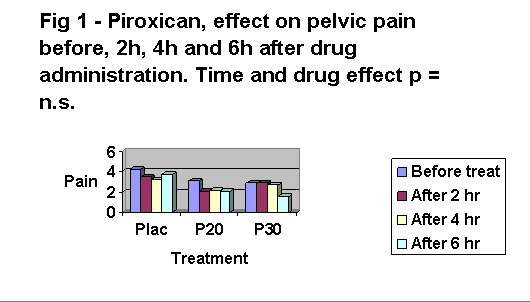 |
Figure 2 shows the before / after treatment effect. Drug and placebo decreased significantly the pain (P = 0,006) after 2 to 4 days of the end of treatment. There was no difference between drug and placebo. |
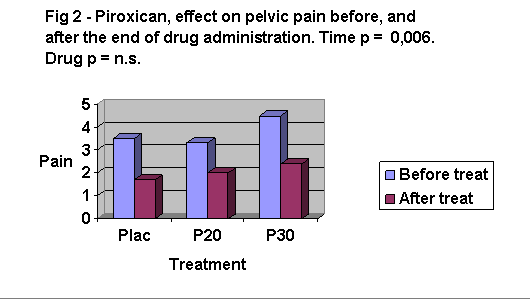 |
Figure 3 shows pain on uterus mobilization. Drug and placebo decreased significantly the pain (P < 0,01). There was no difference between drug and placebo. |
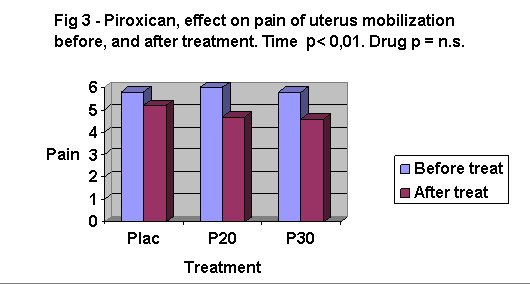 |
Figure 4 shows pain on touch of low abdomen before and after treatment. There was a significant reduction of pain in all treatments (P <0,01) after 2 to 4 days of the end of treatment. There was no difference between piroxican and placebo. |
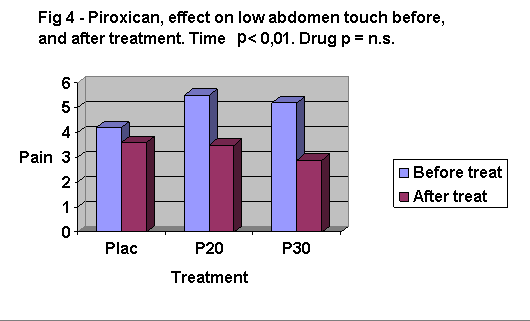 |
Figure 5 compared pareunalgy before and after treatment. Significant reduction was seen in all three treatments (p < 0,01), without difference between drug and placebo. |
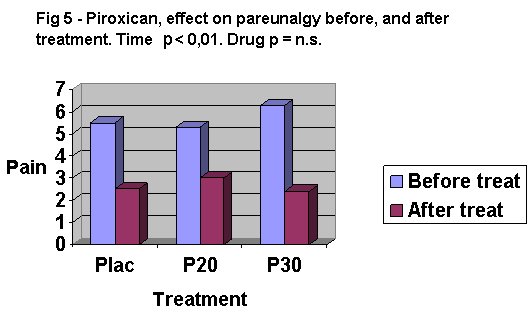 |
Comparison of blood sedimentation rate before and after treatment did not show any difference.
Conclusion
Piroxican at 20mg, 30mg or placebo has the same effective effect on reduction of pelvic chronic pain. There was no difference from drug to placebo

